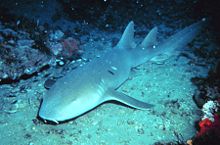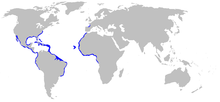Nurse shark
| Nurse shark Temporal range: 112–0 Ma Albian to Present |
|
|---|---|
 |
|
| Scientific classification | |
| Kingdom: | Animalia |
| Phylum: | Chordata |
| Class: | Chondrichthyes |
| Subclass: | Elasmobranchii |
| Order: | Orectolobiformes |
| Family: | Ginglymostomatidae |
| Genus: | Ginglymostoma |
| Species: | G. cirratum |
| Binomial name | |
|
Ginglymostoma cirratum (Bonnaterre, 1788) |
|
 |
|
| Range in blue | |
The nurse shark (Ginglymostoma cirratum) is a shark in the family Ginglymostomatidae. Nurse sharks can reach a length of 3.08 m (10.1 ft), and are native to warmer parts of the Atlantic and East Pacific.
The nurse shark family name, Ginglymostomatidae, derives from the Greek: from γίγγλυμος meaning hinge and στόμα meaning mouth. Cirratum also derives from Greek, meaning curl or swim. Based on morphological similarities, Ginglymostoma is believed to be the sister genus of Nebrius, with both being placed in a clade that also contains the Pseudoginglymostoma brevicaudatum, Rhincodon typus, and Stegostoma fasciatum.
The nurse shark is a common inshore bottom-dwelling shark, found in tropical and subtropical waters on the continental and insular shelves of the Atlantic and East Pacific. It is frequently found at depths of 1 m (3 ft 3 in) or less but may occur down to 75 m (246 ft). Its common habitats are reefs, channels between mangrove islands and sand flats. It can be seen in the Western Atlantic from Rhode Island down to southern Brazil, including the Caribbean; in the Eastern Atlantic from Cape Verde to Gabon (accidental north to France). In the East Pacific it ranges from Baja California to Peru.
...
Wikipedia

